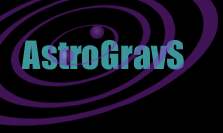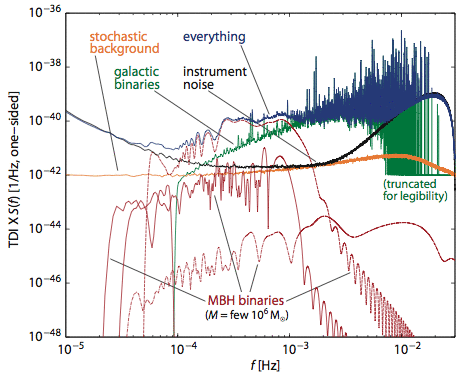This website is kept for archival purposes only and is no longer updated. Skip to content
 Mock LISA Data Challenge
Mock LISA Data Challenge
Round 4 - Data Sets
|
MDLC Round 4 consists
of a single, "whole enchilada" challenge that includes all the sources
of MLDCs 3.1-3.5 in the same dataset.
While the third round of the MLDCs was focused on increasing the
complexity and variety of GW sources, this iteration is devoted
to the global-fit problem of detecting and analyzing sources
of different types superposed in the LISA data.
All Round 3 sources are included, with larger numbers of
EMRIs and cosmic-string bursts and larger parameter ranges for
MBH binaries and EMRIs.
The waveform models are identical to those in Round 3 except for the following changes: the spectra of the cosmic string bursts are truncated below 1e-5 Hz; the stochastic background spectrum is modified; and the MBH binary signals are truncated differently as binary merges. See the 2009 Amadi proceedings article for more details (GoogleCode site). The deadline for Round 4 entries has been extended to 17 June 2011, with preliminary results to be presented shortly thereafter. The global-fit character of this challenge encourages collaborative endeavors between groups that have developed searches for different sources. Note: The datasets were revised on Oct 18, 2010; The correct datasets are in a subdirectory named "svn1159" with data stamps between Sep 29, and Sep 30, 2010; do not use an earlier version. |

|
A graphic representation of a Round 4 training dataset (not the "official" released training dataset). more This particular realization includes 60+ million chirping Galactic binaries, 4 MBH binaries, 9 EMRIs, 15 cosmic-string bursts, an isotropic stochastic background, and of course instrument noise. |
Challenge 4
A two-year (15x2^22 s) dataset with signals of 4-6 MBH binaries, approximately 6 EMRI's, approximately 20 cosmic-string bursts and an isotropic stochastic background, as well as a galactic binary population of ~ 60 million binaries. The signal parameters for various classes of sources are set as follows:The galaxy
These signals are derived from a model of the galactic binary WD-WD population (Nelemans, Yungelson and Portegies Zwart; 2001, 2004) . The population includes 34 million interacting systems and 26 million detached binaries. For each, the gravitational wave frequency may be linearly increasing or decreasing depending on the relative significance of gravitational radiation power and mass transfer.MBH binaries
From 4 to 6 binaries with m1/MSun in [0.5,5e6], m1/m2 in [1,10], a1/m1 in [0,1], a2/m2 in [0,1]. Coalescence times and SNRs are chosen as in Round 2 and Round 3, for a set of BBH signals consisting of (note that the SNR quoted here is only for the inspiral and assumes coherent matched-filtering using 1 TDI observable):- A loud (SNR ~ 2000) signal (with in-spiral in band, that is from f = 0.1 mHz, lasting about 1 week) and coalescing 60 to 120 days after the beginning of the observations
- A moderate-to-low SNR (~ 20) signal with coalescence between 750 and 780 days from the beginning of the observations
- A loud (SNR ~ 1000) signal coalescing between 180 and 720 days from beginning of observations
- A loud (SNR ~ 200) signal coalescing between 180 and 720 days from beginning of observations
- A loud (SNR ~ 100) signal with coalescence taking place between 495 and 585 days from the start of the observations
- A low SNR (~ 10) signal with coalescence taking place between 810 and 840 days from the beginning of the observations
Extreme-mass-ratio inspirals
EMRI parameters are chosen from: mu/MSun in [9.5,10.5], S/M^2 in [0.5,0.7], e_plunge in [0.05,0.25], t_plunge/(15 s) in [2^21,2^22], SNR in [25,50]. Central black hole masses are drawn as follows:- Poisson(2) systems with M/(1e7 MSun) in [0.95,1.05]
- Poisson(2) systems with M/(1e6 MSun) in [4.75,5.25]
- Poisson(2) systems with M/(1e6 MSun) in [0.95,1.05]
Cosmic string bursts
Poisson(20) cosmic string bursts with parameters: log(fmax/mHz) in [0,2], tc drawn uniformly over the duration of the dataset, and SNR in [10,100].Isotropic stochastic background
The spectrum for the background is of the form, S_h = s x 1e-47 (f/Hz)^-3 / Hz, with s in [0.7,1.3].
Several versions of the datasets are released:
fractional-frequency-fluctuation
data generated by
Synthetic LISA and
LISACode,
and equivalent-strain data generated by the
LISA Simulator.
In contrast to MLDCs 3.4 and 3.5, all the LISA
instrument noises are set to symmetric, nominal levels,
and the LISA armlength are allowed to "breathe."
The data are provided at two cadences:
2^22 samples at 15 s sampling and "high-freq"
with 2^25 samples at 1.875 s sampling.
| ||||||||||
|